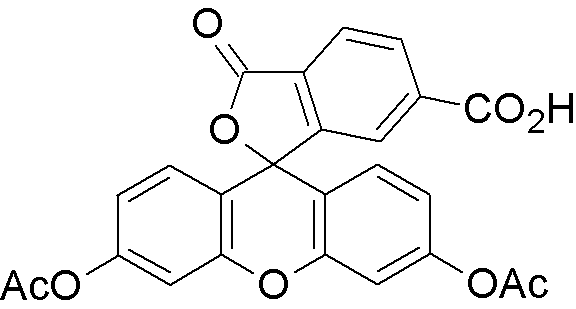6-Carboxyfluorescein diacetate is widely utilized in research focused on:
- Cell Viability Assays: This compound is commonly used in cell biology to assess cell health and viability. Researchers can easily determine the effects of drugs or treatments on living cells.
- Fluorescent Labeling: It serves as a fluorescent probe for labeling cellular components. This application is crucial in microscopy, allowing scientists to visualize and track cellular processes in real-time.
- Drug Delivery Studies: The compound is employed in studies investigating drug delivery mechanisms. Its fluorescent properties help in monitoring the distribution and release of therapeutic agents within cells.
- Environmental Monitoring: It can be used to detect and quantify pollutants in environmental samples, aiding researchers in assessing water quality and contamination levels.
- Biochemical Research: This chemical plays a role in various biochemical assays, including enzyme activity studies, where its fluorescence can indicate reaction progress or product formation.
Informations générales
Propriétés
Sécurité et réglementation
Applications
6-Carboxyfluorescein diacetate is widely utilized in research focused on:
- Cell Viability Assays: This compound is commonly used in cell biology to assess cell health and viability. Researchers can easily determine the effects of drugs or treatments on living cells.
- Fluorescent Labeling: It serves as a fluorescent probe for labeling cellular components. This application is crucial in microscopy, allowing scientists to visualize and track cellular processes in real-time.
- Drug Delivery Studies: The compound is employed in studies investigating drug delivery mechanisms. Its fluorescent properties help in monitoring the distribution and release of therapeutic agents within cells.
- Environmental Monitoring: It can be used to detect and quantify pollutants in environmental samples, aiding researchers in assessing water quality and contamination levels.
- Biochemical Research: This chemical plays a role in various biochemical assays, including enzyme activity studies, where its fluorescence can indicate reaction progress or product formation.
Documents
Fiches de données de sécurité (FDS)
La FDS fournit des informations de sécurité complètes sur la manipulation, le stockage et l’élimination du produit.
Spécifications du produit (PS)
Le PS fournit une description complète des propriétés du produit, notamment sa composition chimique, son état physique, sa pureté et les exigences de stockage. Il détaille également les plages de qualité acceptables et les applications prévues du produit.
Certificats d'analyse (COA)
Recherchez des certificats d'analyse (COA) en saisissant le numéro de lot du produit. Les numéros de lot et de lot se trouvent sur l'étiquette d'un produit, après les mots « Lot » ou « Lot de fabrication ».
Numéro de catalogue
Numéro de lot/série
Certificats d'origine (COO)
Ce certificat d'exploitation confirme le pays dans lequel le produit a été fabriqué, et détaille également les matériaux et composants utilisés et s'il est issu de sources naturelles, synthétiques ou autres sources spécifiques. Ce certificat peut être requis pour les douanes, le commerce et la conformité réglementaire.
Numéro de catalogue
Numéro de lot/série
Fiches de données de sécurité (FDS)
La FDS fournit des informations de sécurité complètes sur la manipulation, le stockage et l’élimination du produit.
DownloadSpécifications du produit (PS)
Le PS fournit une description complète des propriétés du produit, notamment sa composition chimique, son état physique, sa pureté et les exigences de stockage. Il détaille également les plages de qualité acceptables et les applications prévues du produit.
DownloadCertificats d'analyse (COA)
Recherchez des certificats d'analyse (COA) en saisissant le numéro de lot du produit. Les numéros de lot et de lot se trouvent sur l'étiquette d'un produit, après les mots « Lot » ou « Lot de fabrication ».
Numéro de catalogue
Numéro de lot/série
Certificats d'origine (COO)
Ce certificat d'exploitation confirme le pays dans lequel le produit a été fabriqué, et détaille également les matériaux et composants utilisés et s'il est issu de sources naturelles, synthétiques ou autres sources spécifiques. Ce certificat peut être requis pour les douanes, le commerce et la conformité réglementaire.


